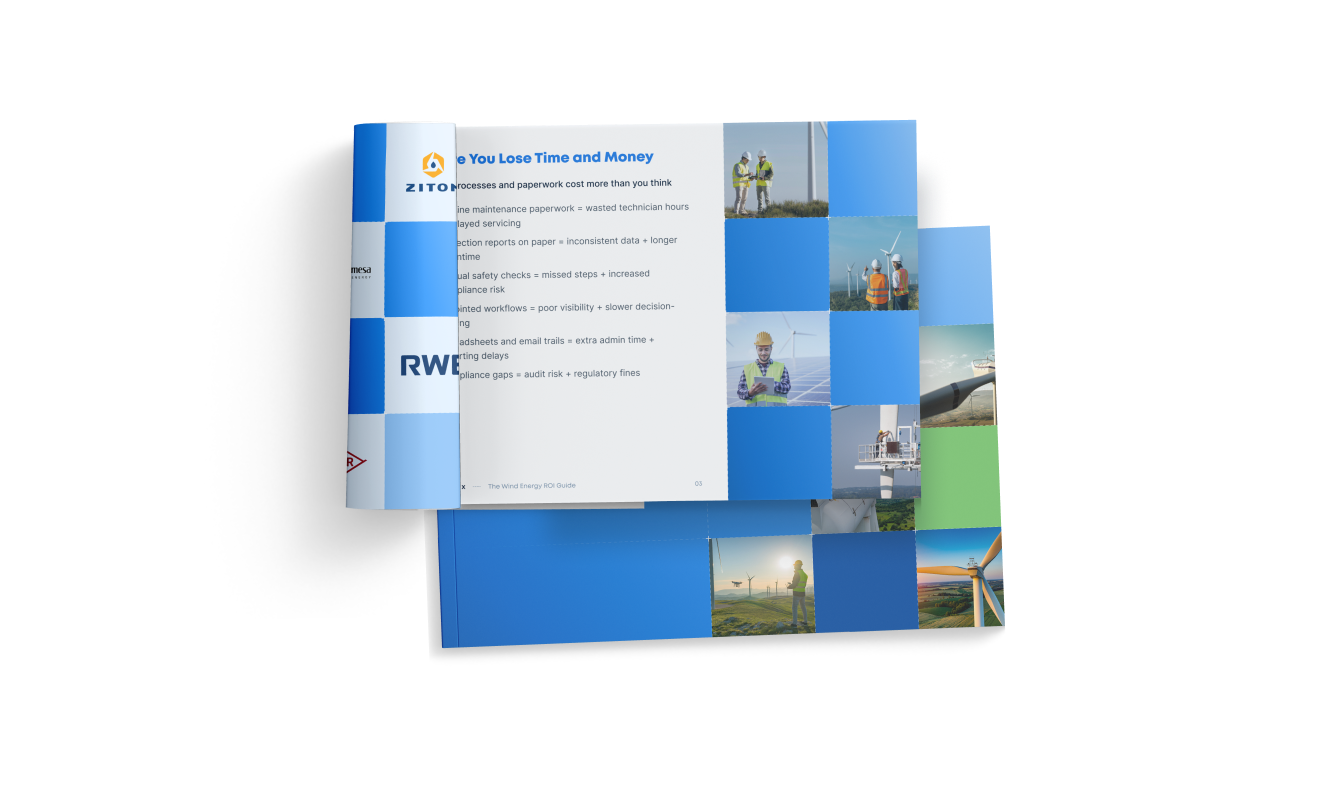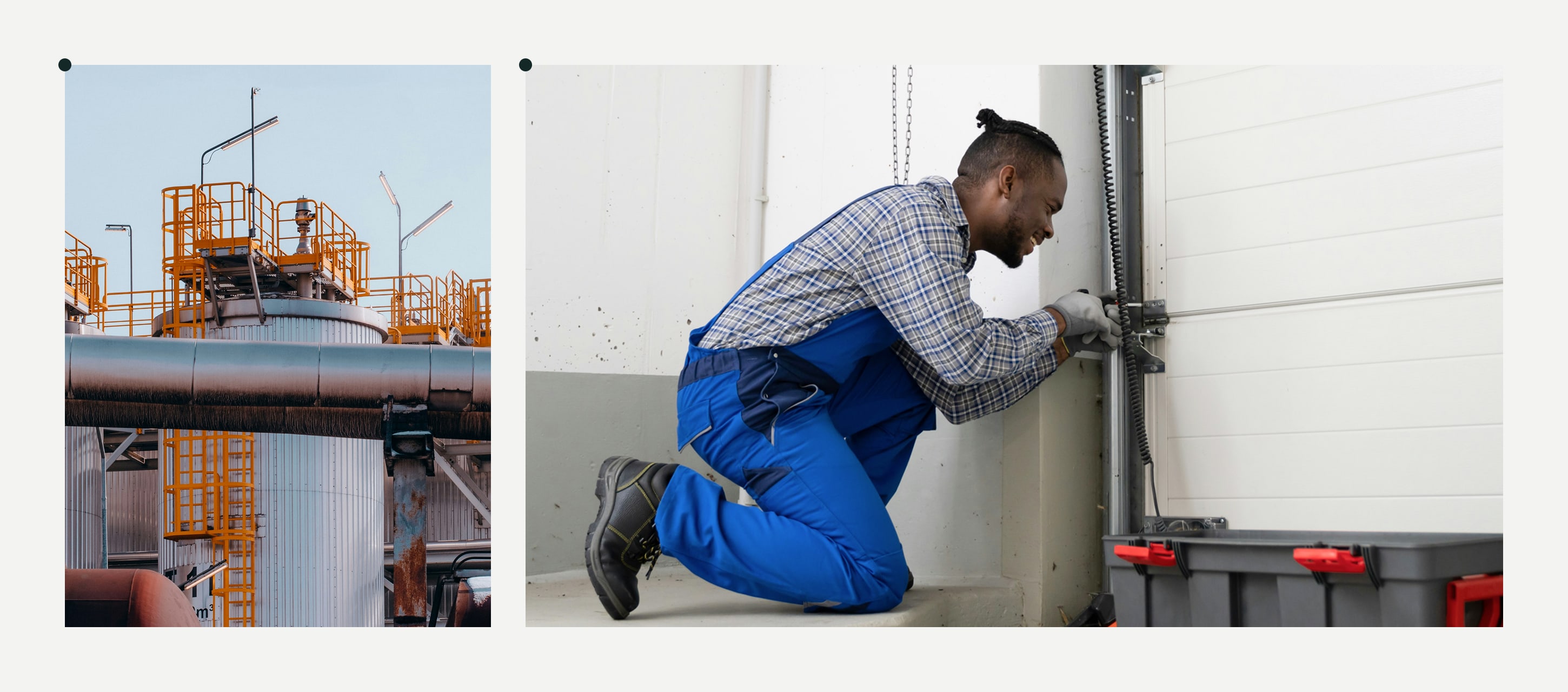Thinking about adding windmills to your property or starting a wind farm?
Maintenance is key if you want your turbines to run efficiently and generate the energy they should. Without a solid plan, you risk unexpected breakdowns, costly repairs, and lost energy production.
So, what does it take to keep wind turbines in top shape? Let’s break it down.
Contents:
What Is Wind Turbine Maintenance?
Wind turbine maintenance is the process of keeping turbines efficient, safe, and operational for as long as possible. It involves inspections, cleaning, lubrication, and repairs to prevent failures and downtime.
Wind turbine technicians, or ‘windtechs,’ handle these tasks. They climb towers over 300 feet high to check for damage, replace worn-out parts, and ensure safety on wind turbines.
They follow established maintenance wind turbine procedures, including the following wind farm maintenance workflows:
- Inspections: Windtechs check turbine blades, the nacelle, the tower, and the generator, identifying potential issues before they become costly failures.
- Cleaning: Dirt and debris impact aerodynamic efficiency. Wind techs clean components to prevent performance losses.
- Lubrication: Grease and oil applied to gearboxes, yaw systems, and rotor shafts reduce wear and extend equipment life. Proper lubrication also lowers failure rates and maintenance costs.
- Repairs: When parts fail, wind techs replace blades, bearings, and gearboxes. They work in remote locations where repairs require hauling heavy equipment hundreds of feet into the air.
Wind techs are the backbone of wind energy. Without them, turbines wouldn’t deliver the power communities rely on.
Which Wind Turbine Elements Should Be Maintained?
Research shows that offshore wind farms are getting bigger, and older turbines are reaching the point where major upgrades or smarter maintenance strategies are needed. Offshore sites, in particular, face unpredictable weather that makes maintenance even more critical.
Here are the key wind turbine elements and essential maintenance tasks that keep them operating at peak performance:
- Rotor components: Turbine blade maintenance includes inspecting for cracks, erosion, and wear; cleaning and repairing$50 as needed for aerodynamics
- Tower structure: Checked for corrosion, stability, and loose bolts; tower cleaning is performed regularly to maintain structural integrity
- Nacelle housing: Inspected for damage, seal integrity, and weatherproofing
- Generator maintenance: Includes lubricating moving parts, aligning bearings, and testing insulation to maintain efficiency. Proper turbine motor maintenance significantly extends equipment life
- Gearbox assembly: Monitored for oil levels, leaks, and wear to prevent failures
- Yaw drive mechanism: Ensures proper wind alignment; gears and motors inspected
- Pitch control system: Adjusts rotor angles for efficiency; sensors and electrical connections verified
- Bearings: Inspected and lubricated regularly to prevent wear and overheating
- Electrical systems: Wiring, control panels, and grounding systems inspected; lightning protection verified
- Slip rings: Checked for wear and lubricated to maintain electrical connectivity
- Hydraulic systems: Inspected for leaks and pressure issues, especially in braking and pitch control
- Foundation and anchoring: Performed along with evaluations for cracks, erosion, and shifting to maintain structural integrity and turbine stability
- Cooling systems: Fans, filters, and heat exchangers inspected to prevent overheating
- Rotor hub assembly: Assessed for structural integrity and pitch mechanism function
- Safety systems: Fire suppression, braking, and emergency stop systems tested for compliance
- Remote monitoring and SCADA systems: Predictive maintenance tools checked for real-time performance tracking
With larger wind turbines, component failures become increasingly costly, leading to downtime and complex repairs. Regular maintenance is key to getting the best out of these investments.
Optimize Safety, Compliance, and Efficiency with Fluix
See how Fluix digital LOTO templates and automated workflows can streamline your wind turbine maintenance
How Often Do Wind Turbines Need Maintenance?
Maintenance schedules vary, but here’s a general guideline:
The U.S. Department of Energy recommends annual maintenance for small wind systems, including bolt tightening, electrical checks, and component replacements (energy.gov). While, Original Equipment Manufacturers (OEMs) recommend maintenance at 4, 6, 12, 24, and 48 months, covering various parts and systems.
Turbine age, operating conditions, and type all affect how often maintenance is required. Offshore turbines and older models typically need more frequent checks.
Types of Maintenance Intervals
Maintenance schedules vary, but here’s a general guideline:
- Routine Maintenance (Every 4-6 months): Involves inspections, lubrication, and minor repairs to prevent unexpected downtime
- Annual Inspections (Once or Twice a Year): A complete mechanical and electrical check-up, requiring around 20 working hours per turbine
- Cleaning (Every 1-2 years, or as needed): Removes debris and pollutants that affect efficiency
- Predictive Maintenance (Ongoing): Some operators use sensor data to schedule maintenance based on real-time turbine conditions rather than a fixed timeline
The Most Common Reasons for Wind Turbine Failures
Wind turbines face constant environmental and mechanical stress, which can threaten performance and technician safety. Studies show that blade damage is a leading cause of turbine failure.
Some of the most common failure points include:
- Leading Edge Erosion: Constant exposure to rain, hail, and airborne debris weakens the blade’s surface, leading to cracks and water infiltration in adhesive bonds
- Blade Tip Damage: High-speed operation makes blade tips vulnerable to erosion, cracking, and lightning strikes, which can lead to structural separation
- Trailing Edge Failures: Debonding and buckling caused by peeling stresses and torsion loads weaken adhesive joints, leading to premature failure
- Root Region and Plydrop Failures: Extreme stress at the blade’s hub connection can cause delamination, debonding, and fatigue failure in thickness transition areas
- Adhesive Joint and Bond Line Failures: Weakening of adhesive joints at blade edges and spar connections can lead to instability and potential blade collapse
- Structural Collapse and Buckling: Aerodynamic, gravitational, and torsional loads can cause local or global buckling, often starting with blade shell or adhesive joint failure
- Cooling System Failures: Overheating in gearboxes, generators, and electrical systems due to clogged filters or malfunctioning fans can lead to shutdowns and permanent damage
- Yaw System and Pitch Control Malfunctions: Sensor errors, mechanical wear, or lubrication failures can misalign turbines, reducing efficiency and increasing structural stress
Wind techs are wind energy’s unsung heroes. Their skill and quick thinking don’t just prevent breakdowns. They keep the entire system running, ensuring communities get the clean energy they rely on.
Read More Read More How Drax completes maintenance inspections over 2 times faster with digital forms
Types of Wind Turbine Maintenance
Wind turbine maintenance procedures fall into two key categories: planned and unplanned.
Knowing the difference helps you prevent costly breakdowns, extend turbine lifespan, and optimize energy production.
1. Planned (Scheduled) Maintenance
Planned wind turbine operation and maintenance is proactive and designed to minimize wear and tear while maximizing turbine performance.
- Preventive Maintenance: Wind turbine technicians follow a structured schedule, often conducting routine inspections, including turbine oil change, lubrication, component testing, and part replacements before visible damage occurs
- Predictive Maintenance: This approach leverages data analytics, sensors, and AI-driven diagnostics to monitor the real-time condition of turbine components
2. Unplanned (Unscheduled) Maintenance
Unplanned maintenance is reactive, dealing with unexpected failures. These situations often result in turbine downtime, emergency repairs, and increased operational costs.
- Reactive Maintenance: Repairs are performed only after a failure occurs, making it the most expensive approach due to emergency labor costs, downtime, and potential safety hazards
- Corrective Maintenance: A middle ground between reactive and preventive maintenance, corrective maintenance identifies issues early and addresses them before they cause system-wide failures
Wind Turbine Maintenance Costs
Understanding wind turbine maintenance costs is crucial for budgeting. According to the U.S. Department of Energy Wind Energy Technologies Office, capital expenditures for wind energy are:
- Land-based wind: $1,200–$1,800/kW (reflecting a 40% drop from 2009 highs)
- Offshore wind: $3,500–$4,000/kW
- Distributed wind: $7,850/kW for small systems and $4,050/kW for systems over 100 kW
Exactly how much does it cost to maintain a wind turbine? Here’s a breakdown:
1. Routine Maintenance Costs
Proactive preventive and predictive maintenance can help operators avoid expensive repairs. According to the same report, land-based wind farms cost operators over $40 per kilowatt annually. These expenses include scheduled inspections and SCADA monitoring for real-time data insights.
2. Repair and Replacement Costs
When significant components fail, costs can escalate sharply:
- Blade Repair: Erosion and structural damage can cost between $10,000 and $50,000 per blade
- Gearbox Replacement: Among the most expensive repairs, costing between $200,000 and $500,000
- Generator Repair: Depending on the severity, turbine generator repair costs can range from $50,000 to $150,000. Basic generator repair might be less expensive but still represents a significant investment.
- Yaw and Pitch System Failure: Repairs typically cost between $20,000 and $50,000
3. Offshore vs. Onshore Maintenance Costs
Offshore turbine maintenance is costly and logistically complex, requiring specialized vessels and careful coordination. That’s why, according to the U.S. Department of Energy, offshore wind O&M costs were 22.15 cents per kWh, while land-based turbines came in at just 8.66 cents per kWh.
4. The High Cost of Unplanned Maintenance
Unexpected failures don’t just slow things down. They can grind operations to a halt. Gearbox failures are among the biggest headaches, often caused by axial or “white-etch” cracking, which can take a turbine offline for weeks. And when O&M costs makeup 25% to over 35% of total energy expenses, the impact on profitability is enormous.
For wind farm operators, staying ahead of these issues is the difference between running a high-performing operation and watching costs spiral out of control.
The Wind Energy ROI Guide
See how Fluix can help you simplify inspections and maintenance, cutting operational costs and saving hours


How to Improve Wind Turbine Maintenance?
A wind turbine maintenance schedule goes beyond hands-on repairs. Technology plays a significant role in improving the efficiency and safety of any modern wind turbine maintenance plan.
Advanced Tools Powering Wind Energy Operations
- Digital Twin Technology: Virtual turbine models enable condition-based monitoring, predictive failure analysis, and performance optimization, reducing reactive maintenance and minimizing downtime during on-site turbine maintenance
- Drone Inspections: Unmanned aerial systems (UAS) with thermal imaging and LiDAR sensors conduct high-resolution blade and tower assessments, eliminating unnecessary climbs and mitigating technician exposure to hazards
- Virtual Reality (VR) Training: Immersive, simulation-based training allows wind techs to experience real-world troubleshooting scenarios, improving diagnostic skills and emergency preparedness
How Software Improves Wind Turbine Maintenance
Modern tools such as Fluix wind turbine operations and maintenance software empower wind energy companies with a comprehensive solution designed to maximize the productivity of wind turbine operation and maintenance work in the field.
- Real-Time Digital Inspections: Wind techs can use customizable digital checklists to conduct thorough blade, gearbox, and electrical system inspections, ensuring nothing is overlooked and compliance is met.
- Instant Access to Critical Documents: Work permits, safety protocols, maintenance manuals, and inspection reports are all available at a moment’s notice, even in remote locations. No more digging through paperwork while hundreds of feet in the air.
- Automated Workflows: Reduce human error by streamlining maintenance schedules, assigning tasks, and ensuring technicians know precisely what needs to be done and when.
Fluix improves safety and efficiency. It also gives wind techs the confidence to focus on the job, knowing they have the tools to work smarter and stay protected.
Winding Up
Wind turbine maintenance procedures aren’t just tasks on a checklist. It’s what keeps operations efficient, safe, and profitable. From planned inspections to reactive repairs, having a proactive strategy reduces downtime, extends turbine lifespan, and cuts operational costs.
But why stop there? With the right wind turbine O&M software, you can automate workflows, streamline inspections, and give field teams instant access to critical documents, even 100 meters high and many miles away on an offshore wind turbine.





